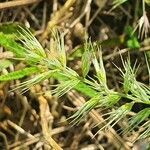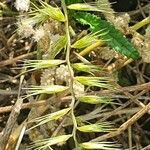Loosely tufted annual, 130-820 mm high. Leaf blade 45-280 x 4-8 mm; ligule a fringed membrane. Inflorescence up to 240 mm long, of many dense, very compact racemes on a central axis; racemes up to 50 mm long; rachis flattened, deflexed at maturity; lower spikelets of each raceme often replaced by small deciduous branchlets. Spikelets 5.7-9.0 mm long, laterally compressed; glumes ± equal, 6.0-8.2 mm long, as long as to longer than spikelet, 1-nerved, keeled, acuminate, awn straight, scabrid. Florets 1-3, bisexual; lemma membranous, less firm in texture than glumes, acute to emarginate, 3-nerved, keeled, mucronate, minutely awned or not; anther 0.4-0.5 mm long, light brown. Flowering time Dec.-May.
Erect or prostrate, laxly tufted. Flowering culms 15–120 cm high. Leaves: basal sheaths glabrous; ligule c. 1 mm long; blade flat (when fresh), 10–21 cm long, 4–10 mm wide, adaxially sparsely pilose. Inflorescence branches 2–6 cm long. Spikelets 5–8 mm long, with 1–3 bisexual florets. Glumes 4–8 mm long including the awns, 2-nerved. Basal lemma ovate, 2 mm long, carinate or rounded on back, muticous, glabrous. Palea nearly equal to the lemma body, ovate.
An annual grass. It forms tufts which are straggling. These lie over and root at the nodes. The leaf blades are narrow and flat. It is green or purplish green and 50 cm high. The leaf blades are narrow and flat. They are 3-25 cm long by 0.3-0.5 cm wide. They taper to the tip. The flowerings stalk is 6-20 cm long and narrowly oblong and open. The flower is made up of many spikes all turned to one side and irregularly arranged.


